Nestled in the Chinsurah subdivision of Hooghly district is the home of the Dhaniakhali taant sari. Known for their lasting texture and a dreamy fall, the weaves have long been the pride of Bengal. Weaved upon 100 and 80 count-treads, these saris come in a host of colours. Usually, 5.5 metres long with a width of 48 inches (approximately), the saris were originally woven in white and grey. Their borders or paar were woven with pre-dyed yarns of red, orange, violet and green. The plain-coloured dobby borders, popularly known as maatha paar or beluaari paar, were the trademarks of Dhaniakhali saris along with the Khejurchuri, which was woven on the weft of the pallus.
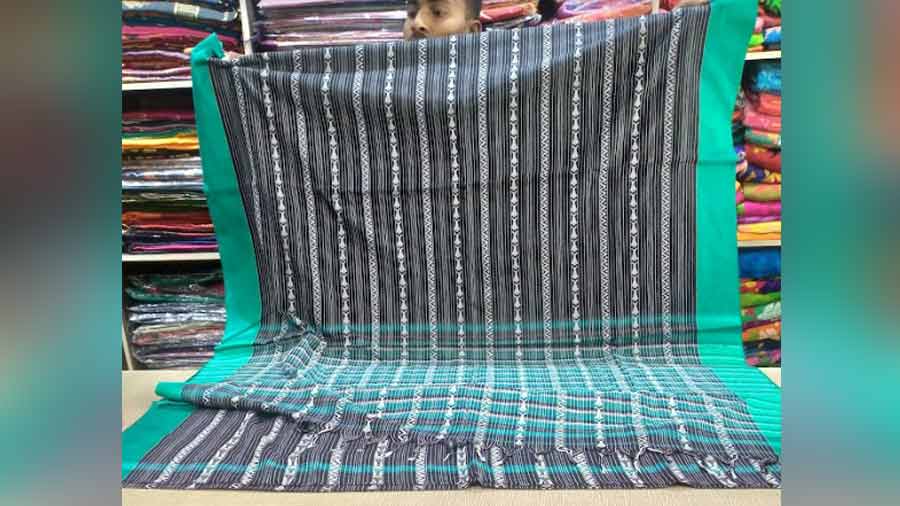
A traditional fish motif re-created on a soft Dhaniakhali Photos by Barnini Maitra Chakraborty
Laal paar, machch dure, barfi daant dure are some of the traditional designs in Dhaniakhali saris. However, many new designs have been incorporated to keep up with modern buying patterns.
Fresh off the loom
The Bengal taant is complex — the weave only attains its defining thickness upon the application of starch to the warp, which strengthens and protects the yarn from abrasion. The starch, or maar, is essential to this gharana of handloom.
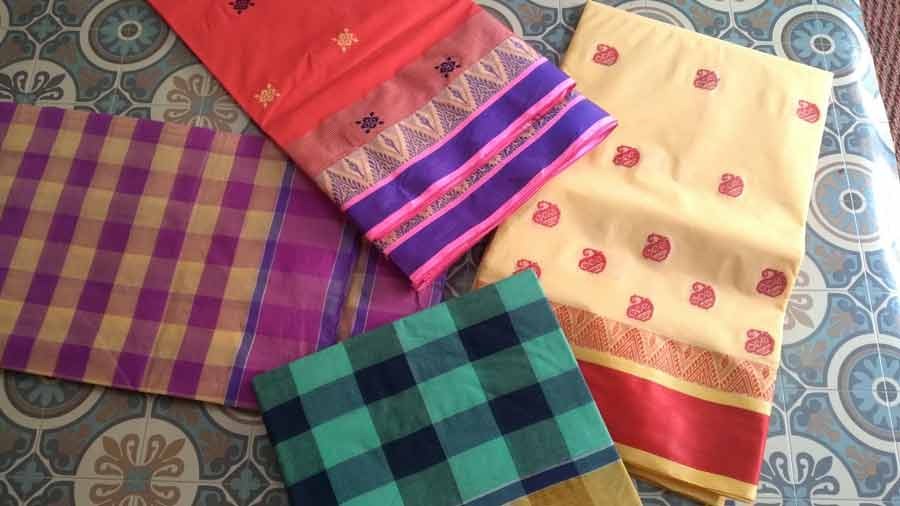
Starched Dhaniakhali saris
The starch is a mixture of sago seeds, wheat, puffed paddy, arrowroot and rice. A bamboo reed known as sar reed is popularly used to group two warp threads to attain the desired texture. The Dhaniakhali originally earned its popularity as fine-quality dhotis. Though dhotis are still available, the saris are what earned the handloom its GI tag. Other than Dhaniakhali village, which houses a number of weavers, (though the number has dwindled over the years) places like Atpur, Gurap, Haripal also weave Dhaniakhali saris.
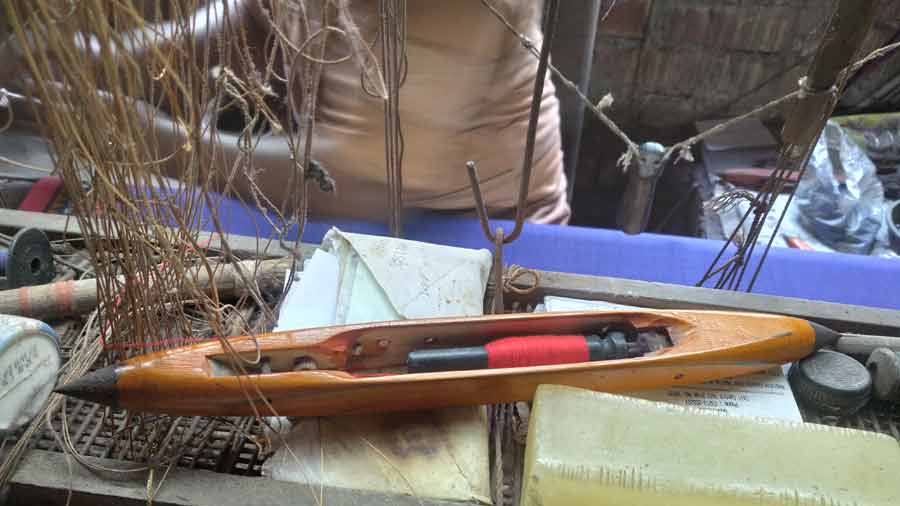
A ‘maku’ on which the reel of thread is attached
Most members of weaver families are associated with the labour-intensive production process. While the mothers, wives, sisters usually prepare the threads for the looms, the male members look after the weaving procedure. The cutting of the thread is known as noli baata. In the shuttle (or maku), the thread reel (noli) is set, explains Rita Dey, wife of the weaver Kesabh Dey.

Rita Dey prepares the threads on a ‘noli baata’ machine
In the household of the weaver Prafulla Das, we were introduced to two types of machines (or charka) for cutting the threads. One is used to apply starch to the thread, the other is used to cut the thread. Prafulla Das’s wife passed away years ago and his sister prepares the thread for the weaves.
Tales of ‘taant’
Another taanti, Swadesh Das, gave a glimpse into the meticulous process of weaving the saris. At the drum room (drum ghor), where threads are given the final touch-up (a process known as joron), rests a huge drum-like structure, which cuts the threads. The middle portion of the machine is for developing the body of the saree (known as meeje) and the sides are for the borders (daant).
Das usually takes three to four days to weave one sari. However, he is not too happy with the state of things. Das has even been looking for a better-paying job. He said it is difficult to stick to weaving as his primary source of income in the age of advanced looms, considering how little he makes.
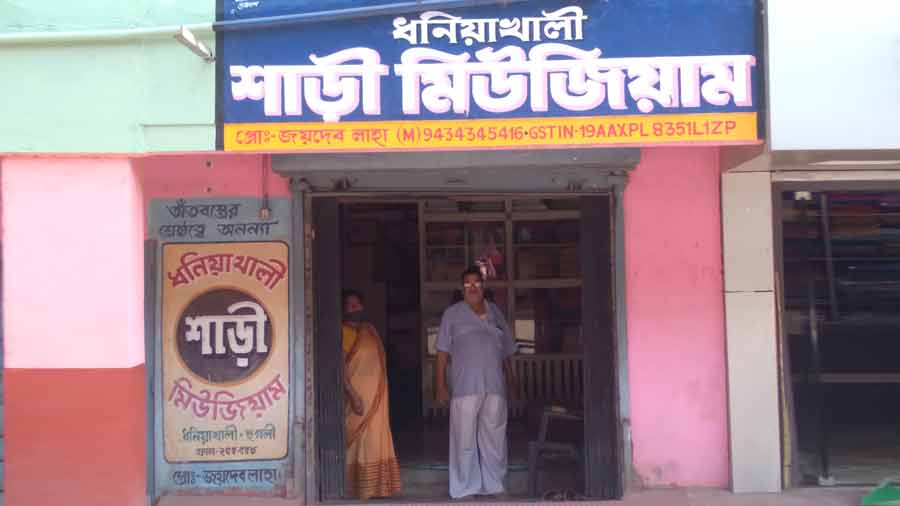
The Dhaniakhali Sari Museum
One of the most prominent shops in Dhaniakhali is the Dhaniakhali Sari museum, which has been selling saris for the last 84 years. Proprietor Joydeb Laha and his son Sujoy Laha are wholesalers and offer authentic Dhaniakhali weaves at pocket-friendly prices. Customers can call 9832979558 to place an order.
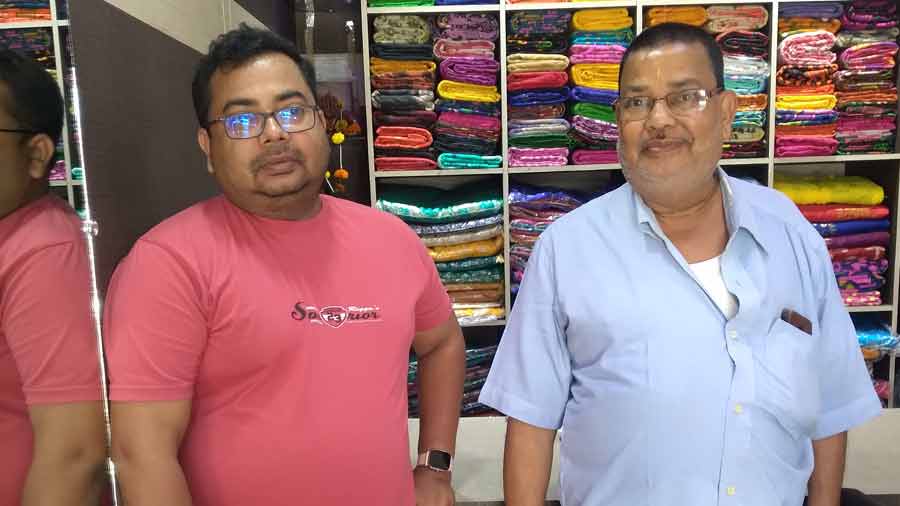
Joydeb (left) and Sujoy Laha, who own the Dhaniakhali Sari Museum
Laha pointed out his shop has two parts. The older part is reserved for starched Dhaniakhali weaves, cotton-tussar saris and dhotis, while the other half is a new set-up that stocks a collection of soft Dhaniakhali saris, which are flowy, starch-free and popular with modern buyers.
How to reach Dhaniakhali:
- The distance between Dhaniakhali and Kolkata is around 61 kms and can be commuted via rail or road
- By train, the Howrah-Burdwan local can get you to Dhaniakhali Halt
- By road, Durgapur Expressway is the best bet. After crossing Dankuni, drive straight towards Maheshpur. The road turns left from this juncture and Dhaniakhali is about 14 km from here.
- The Dhaniakhali Sari Museum is located in the bazar near an Axis Bank ATM

